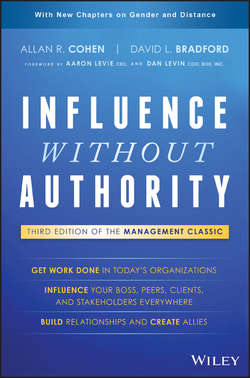Influence Without Authority

Реклама. ООО «ЛитРес», ИНН: 7719571260.
Оглавление
Cohen Allan R.. Influence Without Authority
DEDICATION
FOREWORD
ACKNOWLEDGMENTS
PART I. INTRODUCTION
CHAPTER 1. WHY INFLUENCE: WHAT YOU WILL GET FROM THIS BOOK
Sachin Bhat Is Asked to Step In
Why an Influence Model?
Barriers to Influence
Overcome the Barriers: Use an Influence Model to Guide You
Plan, But Do Not Come Across as Self-Seeking
Get “Two for the Price of One”
The Book's Organization
PART II. THE INFLUENCE MODEL
CHAPTER 2. THE INFLUENCE MODEL: TRADING WHAT THEY WANT FOR WHAT YOU'VE GOT (USING RECIPROCITY AND EXCHANGE)
Ignore the Law of Reciprocity at Your Peril
Exchange: The Art of Give and Take That Permeates All Influence Tactics
The Cohen-Bradford Influence without Authority Model
Self-Created Barriers to Influencing
CHAPTER 3. GOODS AND SERVICES: THE CURRENCIES OF EXCHANGE
Coin of the Realm: The Concept of Currencies
Frequently Valued Currencies
Some Cautions
Using Currencies: Complexities and Restrictions
Expanding Your “Currency Pool”
Self-Traps in Using Currencies
Pay in the Currency Others Value, Not Just What You Would Value
Resenting Having to Go Out of the Way
A Word of Warning: Beware False Advertising
Last Word: Some Currencies Really Are Not Convertible
CHAPTER 4. HOW TO KNOW WHAT THEY WANT: UNDERSTANDING THEIR WORLDS (AND THE FORCES ACTING ON THEM)
Two Forces That Can Explain All Behavior
How to Know What Might Be Important to the Other Person
The Potential Ally's Environment
Where Are They Headed? Career Aspirations and Personal Background
The Potential Ally's Worries
Gathering Real-Time Data about the World of Others
Just Because It Waddles and Quacks Like a Duck Doesn't Mean It's a Duck: The Dangers of Stereotyping
Barriers to Acting on Knowledge of the Worlds of Important Stakeholders
The “Selective Confirmation” Bias
Further Decreases in Interaction
Alternatives to Creating Distance and Limiting Influence
I Thought You'd Never Ask: Using Direct Inquiry as an Alternative
Conclusion: Barriers to Understanding the World of Others
CHAPTER 5. YOU HAVE MORE TO OFFER THAN YOU THINK IF YOU KNOW YOUR GOALS, PRIORITIES, AND RESOURCES
Power Sources: You Are Plugged In
What Do You Want Anyway? Gaining Clarity on Your Objectives
What Are Your Primary Goals and What Are Secondary?
Personal Factors That Get in the Way
Reframing a Personal Need into a Possible Benefit to the Boss; (Jim and Wes)
CHAPTER 6. BUILDING EFFECTIVE RELATIONSHIPS: THE ART OF FINDING AND DEVELOPING YOUR ALLIES
Relationships Matter
Dealing With the Situation When the Relationship Is Bad
When to Proceed with a Task or Initiate a Direct Discussion to Improve a Relationship
Conclusion
CHAPTER 7. STRATEGIES FOR MAKING MUTUALLY PROFITABLE TRADES
Planning Your Strategies for Exchange
Free-Market Trades: Clear Mutual Gain
Showing How Cooperation Helps the Potential Ally Achieve Goals
Uncovering – and Trading For – Hidden Value
Compensated Costs
Strategies That Use the Time Value of Currency
Building Credit: Saving for a Rainy Day
Sleaze Alert
Calling in Past Debts
Borrowing on Credit: Deferred Payment/Collateral
Other Strategic Considerations: Who and Where?
Five Dilemmas to Be Managed during Exchanges
Starting and Stopping the Exchange Process
After the Exchange: Checking Out the Process
Making Satisfactory Exchanges and Avoiding Self-Traps
PART III. PRACTICAL APPLICATIONS OF INFLUENCE
CHAPTER 8. GENDER AND INFLUENCE: BEYOND STEREOTYPES. COAUTHOR, NAN LANGOWITZ
Introduction
Conclusions
CHAPTER 9. INFLUENCING YOUR BOSS
The Approach
True Grit: Being a Worthy Partner
CHAPTER 10. WORKING CROSS-FUNCTIONALLY: LEADING AND INFLUENCING A TEAM, TASK FORCE, OR COMMITTEE
The Challenge of Gaining Commitment
Increasing the Attractiveness of the Project
Using Vision, a Valuable Common Currency
Deciding How the Team Will Operate
Selling Solutions before Formally Presenting Them
CHAPTER 11. INFLUENCING ORGANIZATIONAL GROUPS, DEPARTMENTS, AND DIVISIONS
How to Go about Gaining Influence: Applying the Model
Preferences in How to Be Approached
Ways People Self-Limit Their Influence
CHAPTER 12. CAN YOU HEAR ME: INFLUENCING AT A DISTANCE
Why Influence at a Distance Has Become So Important
Use of Technology
When Influence Becomes Very Personal (Sarah Does a Layoff at a Distance)
Impacts of Distance on Key Steps of the IWA Model
The Gradual Building of Trust
CHAPTER 13. INFLUENCING DIFFICULT COLLEAGUES
Friendly Competitors: “Co-Opetition”
Overcoming Mistrust
Dealing with Hard Bargainers
Treat Everybody as a Long-Term Customer
Dealing with Colleague Behavior That Is Annoying or Worse
The Problem of the Colleague's Maddening Behavior
CHAPTER 14. INITIATING OR LEADING MAJOR CHANGE
No Money and No Authority
The Importance of Vision
Manage Tension
Identify Key Stakeholders Who Must Be Influenced
How to Influence Distant Stakeholders
Is Your Elevator Pitch Ready?
Influence the Influencers They Listen To
What Do You Have to Offer?
Diagnose and Enhance the Relationship
Develop Your Exchange Strategy
Change Roles: Moving among Different-Size Groups
Planning versus Calculation
Further Ideas about Change
CHAPTER 15. UNDERSTANDING AND OVERCOMING ORGANIZATIONAL POLITICS
The Nature of Organizations
Culture Determines the Way Politics Are Played
Get the Lay of the Land
Collecting Political Information
Diagnose Stakeholders
The Importance of Knowing Yourself
Lessons from Fran Grigsby's Political Experiences at Commuco
CHAPTER 16. HARDBALL: ESCALATING TO TOUGHER STRATEGIES WHEN YOU CAN NO LONGER CATCH FLIES WITH HONEY
Raising Your Ally's Costs – Gradually
When Your Boss Is the Difficult Colleague
Who Has the Power? – Recognizing Your Power, Increasing It, and Using It Appropriately
The Ultimate Escalation: Betting Your Job
Into Every Life Some Rain Must Fall: Rotten Apples and Hardball
The Calculated Confrontation
Be Careful of Assuming Malevolence
Conclusions
APPENDIX A. EXTENDED CASE EXAMPLES AND SUPPLEMENTARY MATERIAL AVAILABLE ON THE WEB
APPENDIX B. ADDITIONAL RESOURCES
Отрывок из книги
The concepts seem so obvious, so basic.
Would anyone argue with these simple ideas? Of course not.
.....
Although the concept of give and take is in many ways simple and straightforward, the process of exchange is more complicated. We have found that there are six essential components (Figure 1.1).
Figure 1.1 Summary of the Cohen-Bradford Model of Influence without Authority
.....